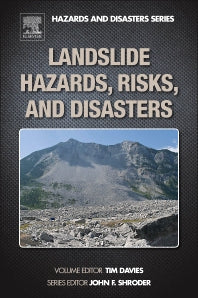Freshly Printed - allow 10 days lead
Couldn't load pickup availability
Landslide Hazards, Risks, and Disasters
Landslide Hazards, Risks, and Disasters, a book in Elsevier’s Hazards and Disasters series, addresses landslides, mass movement, quick sand, ground collapses, and problem soils that are influenced by a combination of in-ground factors as well as climate change and variations in weather.
John F. Shroder (Editor-in-chief), Tim Davies (Edited by)
9780123964526
Hardback, published 11 November 2014
492 pages, 150 illustrations (150 in full color)
22.9 x 15.1 x 3 cm, 1.1 kg
Landslides are the most costly geo-hazard in the world, and they’re often the cause or the result of other hazards and disasters such as tsunamis, earthquakes, wildfires, and volcanic eruptions. Landslide Hazards, Risks, and Disasters makes a close and detailed examination of major mass movements and provides measures for more thorough and accurate monitoring, prediction, preparedness, and prevention. It takes a geoscientific approach to the topic while also discussing the impacts human-induced causes such as deforestation, blasting, and building construction—underscoring the multi-disciplinary nature of the topic.
Introduction; Mass movement classification; Mass movement in soils; Soil creep and valley bulging; Mass movement in bedrock masses; Slope stability analysis; Slope monitoring; Landslide hazard, investigation, and mapping; Cost-effective slope stabilization; Quicksands; Expansive clays; Dispersive soils; Collapsible soils; Quick clays; Problem-soils as most expensive geohazard in world; Role of water in mass movement and problem soils; Undersea landslides; Subsidence; Snow avalanches; Arid soil hazards; Peat and coalbed hazards; Climate change and increased mass movement in collapse of permafrost regions; Paleoslope failures; Dating mass movements and ground collapses; Field, aerial photograph, and remote sensing assessments; Quantitative analysis; Living near steep slopes & valley margins; Community preparedness, response & recovery; Implications of climate change.
Subject Areas: Natural disasters [RNR], Nuclear issues [RNQ], Earth sciences [RB]


